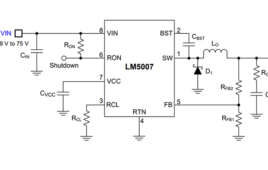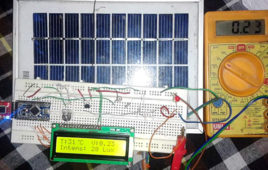Inductors are simple components in electronic devices that perform tasks like cleaning up electrical signals, helping with timing, and managing power. They store energy in magnetic fields when electricity flows through them and releases them back into the circuit. Inductors resist sudden changes in the flow of electricity, pushing back “spikes” by creating an electrical…
Component selection for low power embedded systems
Selecting components is one of the most essential and critical processes when designing any electronic system. Poor component selection can lead to many problems within the design, PCB layout, power budget, etc. In this article, we will discuss how to select a component for a low-power-optimized design. Resistor The power dissipated by a resistor is…
Diodes launches bidirectional current monitors based on a zero-drift architecture
Diodes Incorporated has announced a series of bidirectional current monitors based on a high-stability zero-drift architecture. These devices are capable of accurately measuring very low sense voltages across a wide range of common-mode voltages. Key applications include laptop PCs, battery chargers, industrial servos, servers, power-supply racks in server farms, and robotic systems. Consisting of six…
Vishay launches new high-precision, thin-film wraparound chip resistor
Vishay Intertechnology, Inc. has introduced a new high-precision, thin-film wraparound chip resistor for industrial, military, and aerospace applications. In addition to offering the widest resistance value range on the market, the Vishay Sfernice PEP delivers higher power ratings in smaller case sizes than competing devices, which enables miniaturization and increases reliability by reducing the mechanical stress…
How to display LDR and soil-moisture sensor values using an OLED
In Part I of this tutorial, we learned how to present data (or values) using a potentiometer (POT) and an organic light-emitting diode (OLED) display. For this project, the POT was an analog sensor (potentiometers can also be digital), which acts as a resistor to control the flow of an electric current. The OLED technology…
Vishay adds to its TNPV e3 series of thin-film, flat-chip resistors
Vishay Intertechnology has announced that it has extended its TNPV e3 series of automotive-grade, high-voltage, thin-film, flat-chip resistors with a smaller 0805 case size. The Vishay Draloric TNPV0805 e3 is the industry’s first such device in the compact 0805 case size to combine high-operating voltages to 450 V with tight tolerance of ± 0.1 %…
Vishay offers new, AEC-Q200-qualified wirewound charging resistor
Vishay Intertechnology has introduced a new, AEC-Q200-qualified charging resistor that is the industry’s first device to feature hybrid wirewound technology in a standard package size. With a high operating temperature range up to +250° C, the Vishay MCB HRHA will serve as a pre-charge and discharge resistor in inverters and converters for electric (EV), hybrid electric…
Vishay enchances its series of automotive-grade, thin-film chip resistors
Vishay Intertechnology announced that the company has enhanced its MC AT precision series of automotive-grade, thin-film chip resistors with a wider range of resistance values in the 0402, 0603, and 0805 case sizes. The Vishay Beyschlag devices combine their high resistance values with TCR of ± 25 ppm/K, tight tolerances of ± 0.1 %, and…
Vishay’s new panel potentiometer delivers industry-high rotational torque
Vishay Intertechnology announced a new modular panel potentiometer that delivers industry-high rotational torque of 8 Ncm — which is 200% higher than the closest competing device. It is ideal for off-road, aeronautics, and industrial applications. Featuring up to seven modules, the Vishay Sfernice P11H is offered in a compact 12.5 mm size, with a 6.35…
Vishay releases new thick-film chip resistors with higher power ratings
Vishay Intertechnology announced that it has enhanced the Vishay Draloric RCC1206 e3 thick-film chip resistor in the 1206 case size with a higher power rating of 0.5 W. Offering twice the power of standard thick-film chip resistors in this size, the RCC1206 e3 can be used in place of two parallel 1206 devices or a…
Solar Panel Parameters Monitoring Using Arduino
There are Power Stations for Maintaining or Monitoring the Power Circuits or Parameters related to Solar Panel. Parameters like Voltage, Temperature, Light Intensity and Current, which are important to monitor. The Monitoring of these parameters are also important in Households too. So, here we discuss about, How to Monitor Solar Panel Parameters.Working of this circuit is very common. In this circuit all the parameters are in the form of an Analog Form or nature. We have to only convert them in Digital Form or Nature and display these Digital values on the LCD. Some additional circuits are also required for proper Measurement.
Implemetation of BODMAS Rule using IC’s
Everyone has studied this rule in their childhood. It stands for “bracket, “off”, “division”, “multiplication”, “addition”, “subtraction”. A mathematical operation involve a number of operators but they must carry out in a particular order. The circuit described here will help you to practically implement the BODMAS rule which we have studied.The circuit is made with the help of three IC’s namely 7404, 7408 and 4073. 7404 is a hex inverter or NOT gate IC. It is a 14 pin IC and contain 6 individual NOT gate on a single IC. 7408 is a quad 2 input AND gate IC. It contains 4 individual AND gate on a single IC. 4073 is a triple 3 input AND gate. It contains 3 individual AND gate on a single IC. LED, switches and resistors are also used in this circuit.
Insight – How Network Resistor Works
Network resistor is a passive circuit element that is a combination of multiple resistances. It forms a convenient solution when the user needs multiple resistances [[wysiwyg_imageupload::]]while constructing a circuit. The manner in which the constituent resistances are combined can vary according to the circuit requirement. Hence, this type of resistor can be used to condense the circuit with additional benefits of low costs and improved resistance tolerance matching.This Insight covers an A103J 9 pin network resistor. It provides resistance from 10 Ohms to 4.7 Mega Ohms. The small size of the resistor makes it easy to connect to a circuit.In the 9 pinned structure of the resistor, the first pin serves as the common terminal while the other 8 represent resistances. The pin that has a dot or a similar marking (quadrilateral in this case) is the first pin of the resistor.
Insight – How Resistor works
Resistors are one of the most crucial parts of any circuit. They vary from micro-ohms to mega-ohms in terms of their value. Also, they come in various forms like embedded as a chip in an IC, can be a bare metal or can be in form of a conductive plastic. This Insight will give a detailed exploration of carbon film resistor which has a ceramic core. Resistor looks like a solid capsule with leads at both ends which are used to connect it to the circuit. It is interesting to know that the temperature coefficient is in ppm instead of being in °C . This can be explained using a simple example. Consider a resistor with a rating 30 ppm for its temperature coefficient. This means that for every 1°C rise in temperature, the resistance would not change more than 30/10000000 or 0.000030 ohms.
Tutorial on Different Types of Resistors
What is a Resistor? An electric resistor is a two-terminal passive component specifically used to oppose and limit current. A resistor works on the principle of Ohm’s Law which states that voltage across the terminals of a resistor is directly proportional to the current flowing through it. Ohm’s Law: V = IR where V is…
How to detect Electronic Smog
Electrons are invisible to human eye then how can we see the electronic smog existing in our home. Is there any method to see them? Impossible, the only method is to capture the energy from it to activate a circuit for giving a visual indication. When you sit in front of a computer or television,…
Electronic Circuit Breaker
This circuit can sense the overload condition and breaks the power if the load increases above the set point. It is an ideal circuit to protect Uninterrupted Power Supply devices like Inverter.Let us see its working …The Optocoupler MCT2E and the Resistor R3 (1 Ohm 10 Watts) will do the trick. The Optocoupler has an LED and a Phototransistor inside with connecting leads. The LED of MCT2E is connected parallel to the resistor R3 with a current limiter R2 for the LED. The phototransistor of Optocoupler is connected to the transformer derived 9 volt DC through the current limiter R1. The load is connected through the Common and NC contacts of the relay. So it will work normally at power on.
Smart Capacitor power supply
This capacitor power supply can deliver 12 volt DC and 100 mA current to power low current devices. It is provided with surge protection and is totally isolated from mains supply using two capacitors in the phase and neutral lines. So the connected device is safe even if the phase and neutral lines changes. …


















